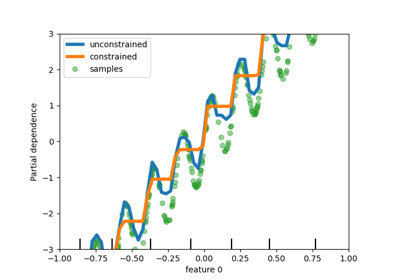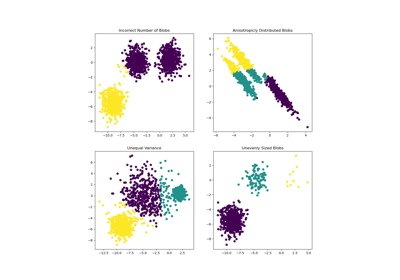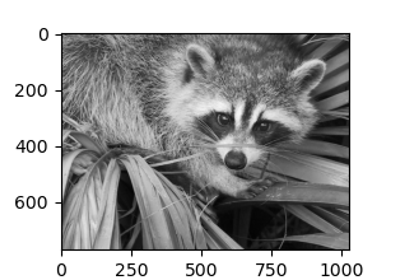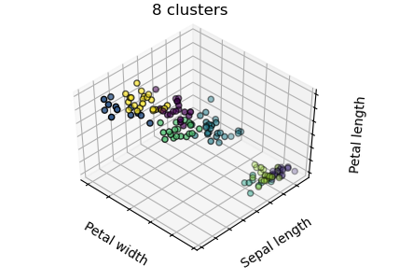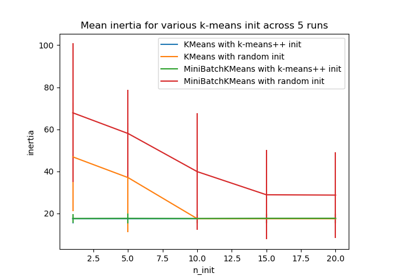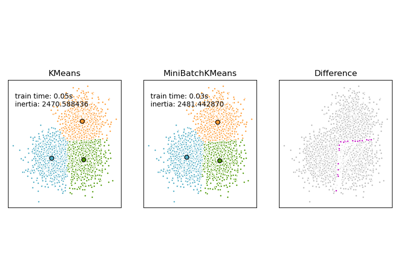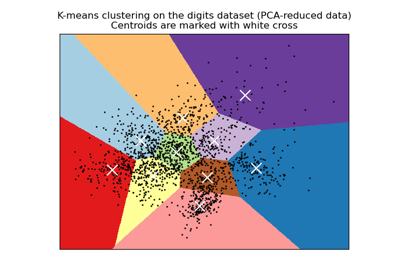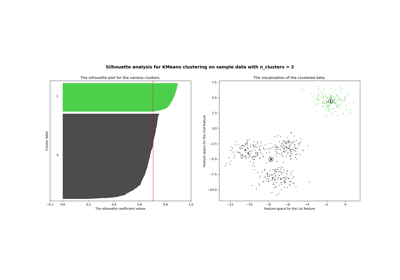sklearn.cluster.KMeans¶
-
class
sklearn.cluster.KMeans(n_clusters=8, *, init='k-means++', n_init=10, max_iter=300, tol=0.0001, precompute_distances='deprecated', verbose=0, random_state=None, copy_x=True, n_jobs='deprecated', algorithm='auto')[source]¶ K-Means clustering.
Read more in the User Guide.
- Parameters
- n_clustersint, default=8
The number of clusters to form as well as the number of centroids to generate.
- init{‘k-means++’, ‘random’, ndarray, callable}, default=’k-means++’
Method for initialization:
‘k-means++’ : selects initial cluster centers for k-mean clustering in a smart way to speed up convergence. See section Notes in k_init for more details.
‘random’: choose
n_clustersobservations (rows) at random from data for the initial centroids.If an ndarray is passed, it should be of shape (n_clusters, n_features) and gives the initial centers.
If a callable is passed, it should take arguments X, n_clusters and a random state and return an initialization.
- n_initint, default=10
Number of time the k-means algorithm will be run with different centroid seeds. The final results will be the best output of n_init consecutive runs in terms of inertia.
- max_iterint, default=300
Maximum number of iterations of the k-means algorithm for a single run.
- tolfloat, default=1e-4
Relative tolerance with regards to Frobenius norm of the difference in the cluster centers of two consecutive iterations to declare convergence.
- precompute_distances{‘auto’, True, False}, default=’auto’
Precompute distances (faster but takes more memory).
‘auto’ : do not precompute distances if n_samples * n_clusters > 12 million. This corresponds to about 100MB overhead per job using double precision.
True : always precompute distances.
False : never precompute distances.
Deprecated since version 0.23: ‘precompute_distances’ was deprecated in version 0.22 and will be removed in 0.25. It has no effect.
- verboseint, default=0
Verbosity mode.
- random_stateint, RandomState instance, default=None
Determines random number generation for centroid initialization. Use an int to make the randomness deterministic. See Glossary.
- copy_xbool, default=True
When pre-computing distances it is more numerically accurate to center the data first. If copy_x is True (default), then the original data is not modified. If False, the original data is modified, and put back before the function returns, but small numerical differences may be introduced by subtracting and then adding the data mean. Note that if the original data is not C-contiguous, a copy will be made even if copy_x is False. If the original data is sparse, but not in CSR format, a copy will be made even if copy_x is False.
- n_jobsint, default=None
The number of OpenMP threads to use for the computation. Parallelism is sample-wise on the main cython loop which assigns each sample to its closest center.
Noneor-1means using all processors.Deprecated since version 0.23:
n_jobswas deprecated in version 0.23 and will be removed in 0.25.- algorithm{“auto”, “full”, “elkan”}, default=”auto”
K-means algorithm to use. The classical EM-style algorithm is “full”. The “elkan” variation is more efficient on data with well-defined clusters, by using the triangle inequality. However it’s more memory intensive due to the allocation of an extra array of shape (n_samples, n_clusters).
For now “auto” (kept for backward compatibiliy) chooses “elkan” but it might change in the future for a better heuristic.
Changed in version 0.18: Added Elkan algorithm
- Attributes
- cluster_centers_ndarray of shape (n_clusters, n_features)
Coordinates of cluster centers. If the algorithm stops before fully converging (see
tolandmax_iter), these will not be consistent withlabels_.- labels_ndarray of shape (n_samples,)
Labels of each point
- inertia_float
Sum of squared distances of samples to their closest cluster center.
- n_iter_int
Number of iterations run.
See also
MiniBatchKMeansAlternative online implementation that does incremental updates of the centers positions using mini-batches. For large scale learning (say n_samples > 10k) MiniBatchKMeans is probably much faster than the default batch implementation.
Notes
The k-means problem is solved using either Lloyd’s or Elkan’s algorithm.
The average complexity is given by O(k n T), were n is the number of samples and T is the number of iteration.
The worst case complexity is given by O(n^(k+2/p)) with n = n_samples, p = n_features. (D. Arthur and S. Vassilvitskii, ‘How slow is the k-means method?’ SoCG2006)
In practice, the k-means algorithm is very fast (one of the fastest clustering algorithms available), but it falls in local minima. That’s why it can be useful to restart it several times.
If the algorithm stops before fully converging (because of
tolormax_iter),labels_andcluster_centers_will not be consistent, i.e. thecluster_centers_will not be the means of the points in each cluster. Also, the estimator will reassignlabels_after the last iteration to makelabels_consistent withpredicton the training set.Examples
>>> from sklearn.cluster import KMeans >>> import numpy as np >>> X = np.array([[1, 2], [1, 4], [1, 0], ... [10, 2], [10, 4], [10, 0]]) >>> kmeans = KMeans(n_clusters=2, random_state=0).fit(X) >>> kmeans.labels_ array([1, 1, 1, 0, 0, 0], dtype=int32) >>> kmeans.predict([[0, 0], [12, 3]]) array([1, 0], dtype=int32) >>> kmeans.cluster_centers_ array([[10., 2.], [ 1., 2.]])
Methods
fit(X[, y, sample_weight])Compute k-means clustering.
fit_predict(X[, y, sample_weight])Compute cluster centers and predict cluster index for each sample.
fit_transform(X[, y, sample_weight])Compute clustering and transform X to cluster-distance space.
get_params([deep])Get parameters for this estimator.
predict(X[, sample_weight])Predict the closest cluster each sample in X belongs to.
score(X[, y, sample_weight])Opposite of the value of X on the K-means objective.
set_params(**params)Set the parameters of this estimator.
transform(X)Transform X to a cluster-distance space.
-
__init__(n_clusters=8, *, init='k-means++', n_init=10, max_iter=300, tol=0.0001, precompute_distances='deprecated', verbose=0, random_state=None, copy_x=True, n_jobs='deprecated', algorithm='auto')[source]¶ Initialize self. See help(type(self)) for accurate signature.
-
fit(X, y=None, sample_weight=None)[source]¶ Compute k-means clustering.
- Parameters
- X{array-like, sparse matrix} of shape (n_samples, n_features)
Training instances to cluster. It must be noted that the data will be converted to C ordering, which will cause a memory copy if the given data is not C-contiguous. If a sparse matrix is passed, a copy will be made if it’s not in CSR format.
- yIgnored
Not used, present here for API consistency by convention.
- sample_weightarray-like of shape (n_samples,), default=None
The weights for each observation in X. If None, all observations are assigned equal weight.
New in version 0.20.
- Returns
- self
Fitted estimator.
-
fit_predict(X, y=None, sample_weight=None)[source]¶ Compute cluster centers and predict cluster index for each sample.
Convenience method; equivalent to calling fit(X) followed by predict(X).
- Parameters
- X{array-like, sparse matrix} of shape (n_samples, n_features)
New data to transform.
- yIgnored
Not used, present here for API consistency by convention.
- sample_weightarray-like of shape (n_samples,), default=None
The weights for each observation in X. If None, all observations are assigned equal weight.
- Returns
- labelsndarray of shape (n_samples,)
Index of the cluster each sample belongs to.
-
fit_transform(X, y=None, sample_weight=None)[source]¶ Compute clustering and transform X to cluster-distance space.
Equivalent to fit(X).transform(X), but more efficiently implemented.
- Parameters
- X{array-like, sparse matrix} of shape (n_samples, n_features)
New data to transform.
- yIgnored
Not used, present here for API consistency by convention.
- sample_weightarray-like of shape (n_samples,), default=None
The weights for each observation in X. If None, all observations are assigned equal weight.
- Returns
- X_newarray of shape (n_samples, n_clusters)
X transformed in the new space.
-
get_params(deep=True)[source]¶ Get parameters for this estimator.
- Parameters
- deepbool, default=True
If True, will return the parameters for this estimator and contained subobjects that are estimators.
- Returns
- paramsmapping of string to any
Parameter names mapped to their values.
-
predict(X, sample_weight=None)[source]¶ Predict the closest cluster each sample in X belongs to.
In the vector quantization literature,
cluster_centers_is called the code book and each value returned bypredictis the index of the closest code in the code book.- Parameters
- X{array-like, sparse matrix} of shape (n_samples, n_features)
New data to predict.
- sample_weightarray-like of shape (n_samples,), default=None
The weights for each observation in X. If None, all observations are assigned equal weight.
- Returns
- labelsndarray of shape (n_samples,)
Index of the cluster each sample belongs to.
-
score(X, y=None, sample_weight=None)[source]¶ Opposite of the value of X on the K-means objective.
- Parameters
- X{array-like, sparse matrix} of shape (n_samples, n_features)
New data.
- yIgnored
Not used, present here for API consistency by convention.
- sample_weightarray-like of shape (n_samples,), default=None
The weights for each observation in X. If None, all observations are assigned equal weight.
- Returns
- scorefloat
Opposite of the value of X on the K-means objective.
-
set_params(**params)[source]¶ Set the parameters of this estimator.
The method works on simple estimators as well as on nested objects (such as pipelines). The latter have parameters of the form
<component>__<parameter>so that it’s possible to update each component of a nested object.- Parameters
- **paramsdict
Estimator parameters.
- Returns
- selfobject
Estimator instance.
-
transform(X)[source]¶ Transform X to a cluster-distance space.
In the new space, each dimension is the distance to the cluster centers. Note that even if X is sparse, the array returned by
transformwill typically be dense.- Parameters
- X{array-like, sparse matrix} of shape (n_samples, n_features)
New data to transform.
- Returns
- X_newndarray of shape (n_samples, n_clusters)
X transformed in the new space.

